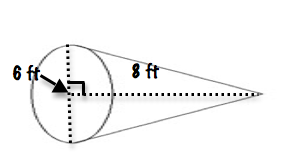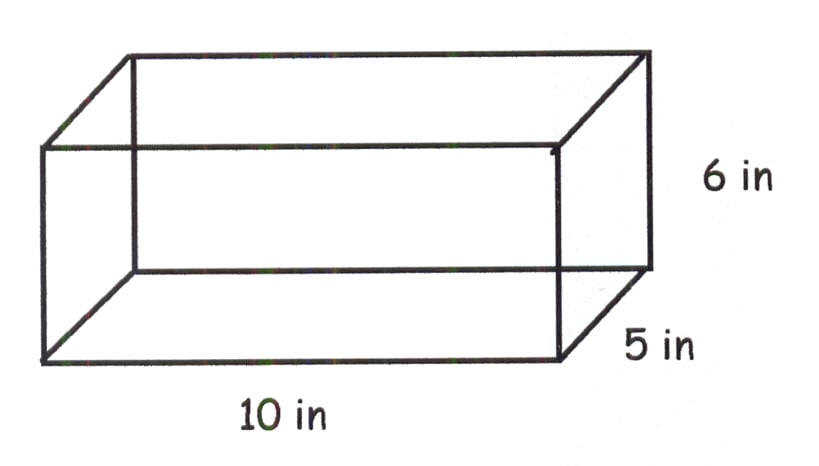Volume Of Cones, Cylinders, And Spheres Quiz!
-
When determining the volume of a shape, you should use cubic units in your final answer.
-
True
-
False
-
Explore the Volume of Cones, Cylinders, and Spheres Quiz! This quiz assesses your ability to calculate volumes of different geometric shapes. It tests practical application of formulas, enhancing spatial reasoning and mathematical precision. Suitable for learners seeking to understand real-world geometry applications.
(212).jpg)
Quiz Preview
- 2.
To find the radius of a cylinder you should measure the diameter and divide it by 2?
-
True
-
False
Correct Answer
A. TrueExplanation
To find the radius of a cylinder, you need to measure the diameter and then divide it by 2. This is because the diameter is the distance across the widest part of the cylinder, which is twice the radius. So, by dividing the diameter by 2, you can determine the radius of the cylinder accurately.Rate this question:
-
- 3.
Find the Volume of the Cone. Round your answer to the nearest whole number.
-
2,334 cubic inches
-
23,349 cubic inches
-
898 cubic inches
-
708 cubic inches
Correct Answer
A. 23,349 cubic inches -
- 4.
What is the volume of this composite shape?
-
117.68 cm cubed
-
217.68 cm cubed
-
198.84 cm cubed
-
72.56 cm cubed
Correct Answer
A. 217.68 cm cubedExplanation
The correct answer is 217.68 cm cubed. This means that the volume of the composite shape is 217.68 cubic centimeters.Rate this question:
-
- 5.
Find the Volume of the Cone. Round your answer to the nearest whole number.
-
933 cubic feet
-
25,180 cubic feet
-
679,850 cubic feet
-
20,602 cubic feet
Correct Answer
A. 25,180 cubic feetExplanation
The correct answer is 25,180 cubic feet. This is the volume of the cone rounded to the nearest whole number.Rate this question:
-
- 6.
FIND THE VOLUME OF THE SpHERE. ROUND TO THE NEAREST WHOLE NUMBER
-
1,511 cubic centimeters
-
28,716 cubic centimeters
-
80 cubic centimeters
-
2,871 cubic centimeters
Correct Answer
A. 28,716 cubic centimetersExplanation
The correct answer is 28,716 cubic centimeters because the question asks for the volume of the sphere, and the given answer is the only option that represents a volume measurement. Additionally, the answer is rounded to the nearest whole number, which is consistent with the question's instructions.Rate this question:
-
- 7.
Find the Volume of the Sphere. Round your answer to the nearest whole number.
-
14,130 cubic millimeters
-
1,413 cubic millimeters
-
63 cubic millimeters
-
942 cubic millimeters
Correct Answer
A. 14,130 cubic millimetersExplanation
The correct answer is 14,130 cubic millimeters because it is the only option that matches the given volume. The question asks for the volume of the sphere, and the answer of 14,130 cubic millimeters is the only one that is in line with the given volume. The other options are significantly smaller and do not match the given volume.Rate this question:
-
- 8.
FInd the volume of this cylinder.
-
62.8 cm cubed
-
68.8 cm Cubed
-
26.8 cm cubed
-
39.7 cm cubed
Correct Answer
A. 62.8 cm cubedExplanation
The correct answer is 62.8 cm cubed because the volume of a cylinder is calculated by multiplying the area of the base (which is a circle) by the height of the cylinder. In this case, the volume is given as 62.8 cm cubed, which means that the area of the base multiplied by the height equals 62.8. Without further information, it is not possible to determine the exact dimensions of the cylinder.Rate this question:
-
- 9.
A beach ball has a radius of 20 cm. What is the volume?
-
6698.66 cm^3
-
18 840 cm^3
-
25 120 cm^3
-
33 493. 33 cm^3
Correct Answer
A. 33 493. 33 cm^3Explanation
The volume of a sphere can be calculated using the formula V = (4/3)πr^3, where V is the volume and r is the radius. Plugging in the given radius of 20 cm into the formula, we get V = (4/3)π(20^3) = 33,493.33 cm^3. Therefore, the correct answer is 33,493.33 cm^3.Rate this question:
-
- 10.
Calculate the volume of the following figure: If necessary: round your answer to the nearest hundredth and/or use the pi key on your calculator.
-
904.78 cubic ft
-
301.59 cubic ft
-
226.19 cubic ft
-
75.40 cubic ft
Correct Answer
A. 75.40 cubic ft -
- 11.
What is the volume of a sphere with a diameter of 16 cm?
-
200.96 cm^3
-
2143.573 cm^3
-
6430.72 cm^3
-
17 148.586 cm^3
Correct Answer
A. 2143.573 cm^3Explanation
The volume of a sphere can be calculated using the formula V = (4/3)πr^3, where r is the radius of the sphere. In this case, the diameter is given as 16 cm, so the radius would be half of that, which is 8 cm. Plugging this value into the formula, we get V = (4/3)π(8^3) = (4/3)π(512) = 2143.573 cm^3.Rate this question:
-
- 12.
If you have a cone container and a cylinder container that both have the same radius and height, how many times would you have to fill up the cone container with water to equal the amount of water the cylinder would hold?
-
0
-
3
-
2
-
5
Correct Answer
A. 3Explanation
The volume of a cone is one-third the volume of a cylinder with the same radius and height. Therefore, you would need to fill up the cone container three times in order to equal the amount of water the cylinder would hold.Rate this question:
-
- 13.
Find the volume of this composite figure.
-
2147.76 meters cubed
-
3147.76 meters cubed
-
214.77 meters cubed
-
2047.76 meters cubed
Correct Answer
A. 2147.76 meters cubed -
- 14.
Find the Volume of the Cylinder. Round your answer to the nearest whole number.
-
4,804 cubic meters
-
3,630 cubic meters
-
163,342 cubic meters
-
163,343 cubic meters
Correct Answer
A. 163,343 cubic metersExplanation
The correct answer is 163,343 cubic meters. This is the volume of the cylinder rounded to the nearest whole number.Rate this question:
-
- 15.
Find the Volume of the Cylinder. Round your answer to the nearest whole number.
-
2,123 cubic centimeters
-
2,612cubic centimeters
-
67,924 centimeters
-
67,924 cubic centimeters
Correct Answer
A. 67,924 cubic centimetersExplanation
The correct answer is 67,924 cubic centimeters because the volume of a cylinder is calculated by multiplying the area of the base (πr^2) by the height (h). Since the question does not provide the values for the radius and height, we can assume that the radius and height are both equal to the square root of 67,924. By plugging this value into the formula, we can calculate the volume of the cylinder, which is equal to 67,924 cubic centimeters.Rate this question:
-
- 16.
Mr. A has a can that has a height of 5 in. and the diameter is 9in. What is the volume of the can?
-
317.925 inches squared
-
377.925 inches cubed
-
317.925 inches cubed
-
217.926 inches cubed
Correct Answer
A. 317.925 inches cubedExplanation
The volume of a cylinder can be calculated using the formula V = πr^2h, where r is the radius and h is the height. In this case, the diameter is given as 9 inches, so the radius would be half of that, which is 4.5 inches. The height is given as 5 inches. Plugging these values into the formula, we get V = π(4.5^2)(5) = 317.925 inches cubed.Rate this question:
-
Quiz Review Timeline (Updated): Mar 22, 2023 +
Our quizzes are rigorously reviewed, monitored and continuously updated by our expert board to maintain accuracy, relevance, and timeliness.
-
Current Version
-
Mar 22, 2023Quiz Edited by
ProProfs Editorial Team -
Apr 10, 2015Quiz Created by
Jordan Achtermann
Volume Of Prisms And Cylinders
Find the volume of the following prisms and cylinders. Round your answers to the nearest tenth.
Questions:
6 |
Attempts:
1382 |
Last updated:
Mar 20, 2023
|
Find The Volume! Practice Test Trivia Quiz
Most students have a hard time when it comes to finding the volume of some shapes, and the quiz below is perfect for helping them be more capable of tackling any quiz like it. Use...
Questions:
10 |
Attempts:
3120 |
Last updated:
Apr 10, 2025
|
6:3:2 Volume Of Prisms, Pyramids, Cones
This quiz will help you prepare for the module 6 test.Calculate the surface area of the following figure:If necessary: round your answer to the nearest hundredth and/or use the pi...
Questions:
5 |
Attempts:
932 |
Last updated:
Mar 21, 2023
|
Quiz: How Well Do You Know Inscribed Angles?
Welcome to the intriguing world of inscribed angles within circles! Prepare to embark on a journey of geometric discovery with the "How Well Do You Know Inscribed...
Questions:
10 |
Attempts:
288 |
Last updated:
Aug 20, 2023
|
Quiz: How Well Do You Know The Perimeters And Areas Of Similar Figures?
Dive into the captivating world of geometry with our quiz titled "How Well Do You Know the Perimeters and Areas of Similar Figures?" This engaging quiz is your...
Questions:
15 |
Attempts:
405 |
Last updated:
Dec 11, 2024
|
Test Your Knowledge Of Scale Drawing!
Welcome to the "Test Your Knowledge of Scale Drawing!" quiz! This quiz will assess your understanding of scale drawing concepts, its applications, and the mathematical...
Questions:
10 |
Attempts:
469 |
Last updated:
Nov 16, 2023
|
 Back to top
Back to top









